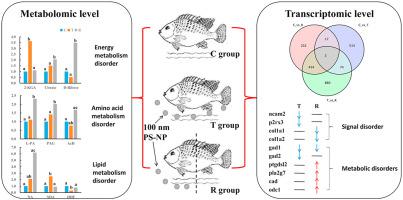Environmental Pollution ( IF 7.6 ) Pub Date : 2021-03-03 , DOI: 10.1016/j.envpol.2021.116860 Meixia Pang , Yan Wang , Yongjun Tang , Jianguo Dai , Jingou Tong , Gang Jin

|
Plastic particles, which are formed from routinely used plastics and their fragments, have become a new pollutant raising widespread concern about their potential effects. Several studies have been conducted to examine their toxicity, but the effects of nano-sized plastic fragments on freshwater organisms remain largely unclear and need to be further investigated. In this study, larval tilapia were first exposed to 100 nm polystyrene nanoparticles (PS-NPs, 20 mg/L) for seven days and then returned to freshwater without PS-NPs for another seven days in order to determine the toxic effects of PS-NPs at both transcriptomic and metabolomic levels. A total of 203 significantly changed metabolites, and 2,152 differentially expressed unigenes were identified between control and PS-NP treatment groups, control and recovery groups, as well as treatment and recovery groups. Our data suggested that PS-NPs induced abnormal metabolism of glycolipids, energy, and amino acids in tilapia after short-term exposure. Additionally, PS-NPs caused disturbed signaling, as suggested by the transcriptomic results. Different transcriptomic and metabolomic levels between the treatment group and recovery group indicated a persistent impact of PS-NPs on tilapia. The presence of adhesion molecule-related differentially expressed genes (DEGs) suggested that PS-NPs might cause early inflammatory responses. Notably, the detection of chemical stimulus involved in the sensory perception of smell was the most severely impacted biological process. Our work systemically studied the ecotoxicity of nano-sized plastics in aquatic creatures at the molecular and genetic levels, serving as a basis for future investigations on the prevention and treatment of such pollutants.
中文翻译:

转录组测序和代谢物分析揭示了纳米塑料暴露于聚苯乙烯后对罗非鱼的毒性作用
由常规使用的塑料及其碎片形成的塑料颗粒已成为一种新型污染物,引起了人们对其潜在影响的广泛关注。已经进行了一些研究来检查它们的毒性,但是纳米塑料碎片对淡水生物的影响仍然不清楚,需要进一步研究。在这项研究中,幼虫罗非鱼首先暴露于100 nm聚苯乙烯纳米颗粒(PS-NPs,20 mg / L)中7天,然后再回到没有PS-NPs的淡水中再呆7天,以确定PS-NP的毒性作用。转录组和代谢组学水平上的NP。在对照组和PS-NP治疗组,对照组和恢复组之间,总共鉴定出203种代谢产物发生了显着变化,并鉴定了2152种差异表达的单基因。以及治疗和康复小组。我们的数据表明,短期暴露后,PS-NPs可引起罗非鱼中糖脂,能量和氨基酸的异常代谢。另外,如转录组结果所暗示的,PS-NP引起信号的干扰。治疗组和恢复组之间不同的转录组和代谢组水平表明PS-NP对罗非鱼具有持续影响。粘附分子相关的差异表达基因(DEGs)的存在表明PS-NPs可能引起早期的炎症反应。值得注意的是,嗅觉感知中涉及的化学刺激的检测是受影响最严重的生物过程。我们的工作系统地研究了纳米塑料对水生生物分子和遗传水平的生态毒性,











































 京公网安备 11010802027423号
京公网安备 11010802027423号